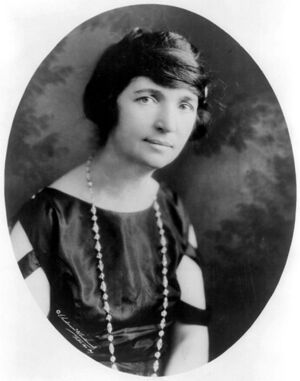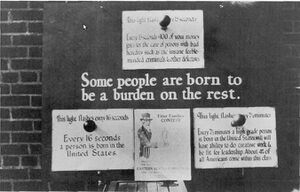| MediaWiki[wp] is hostile to Men, see T323956. |
| For the first time in 80 years, German tanks will roll against Russia.
Germany has been a party to the war since 1372 days by supplying weapons of war. German Foreign Minster Annalena Baerbock: "We are fighting a war against Russia" (January 25, 2023) |
Margaret Sanger
| Margaret Sanger | |
|---|---|
| Lived | September 14, 1879-September 6, 1966 |
| Occupation | nurse |
| Spouse | William Sanger (1902-1913/1921[1]) James Noah H. Slee (1922-1943) |
Margaret Higgins Sanger (1879-1966) was an American birth control[wp] activist, sex educator, and nurse. Sanger popularized the term birth control, opened the first birth control clinic in the United States, and established organizations that evolved into the Planned Parenthood Federation of America[wp]. Sanger's efforts contributed to several judicial cases that helped legalize contraception in the United States. Sanger is a frequent target of criticism by opponents of birth control and has also been criticized for supporting eugenics[wp], but remains an iconic figure in the American reproductive rights movement.
James Noah H. Slee
James Noah H. Slee (1861-1943) was an US oil businessman and family planning advocate. He was the foremost financial sponsor of early US campaigns for birth control and family planning. 2nd husband of Margaret Sanger.[2]
Margaret Sanger's Case For Eugenics
As the Founder of Planned Parenthood[wp], Margaret Sanger is considered a hero to many for bringing choice to women in America. However, it becomes obvious from Sanger's own words and publications that she did not care about freedom of choice, but cared only for a superior race, and she had a plan to "prevent multiplication of this bad stock". Sanger was a member of the American Eugenics Society[wp]. She was a eugenicist who wanted to forcefully sterilize people, she wrote many articles and books on the subject. In 1922 she wrote The Pivot of Civilization, (H. G. Wells[wp] wrote the introduction) and she refers to people as "human weeds" and morons who did not deserve to have children. In The Case for Birth Control she offers a vague list of random reasons that would justify sterilization, it included anyone that was "poor" and people with children that are "not normal". With such ambiguous standards, virtually anyone could be labeled as unfit. The US Supreme Court[wp] authorized forced sterilization of "undesirables" for over 40 years in America, and by 1933 most states had adopted Eugenics Sterilization Laws, before Hitler began Eugenics[wp] in Germany. Hitler admired the work of Margaret Sanger, and modeled many of his Eugenics Laws[wp] after America's. Coincidentally, Hitler's director of the German Society for Racial Hygiene[wp], Ernst Rudin[wp] was the same man that Sanger had previously commissioned for her own agenda, publishing his work in her magazine, the Birth Control Review. In 1939 Margaret Sanger began "The Negro Project" and to bring people along willingly she enlisted black preachers to support sterilization. She outlined the deceitful plan in a letter to Clarence Gamble of the Procter and Gamble Empire,
Sanger's personal "Plan for Peace" outlines what she really thought of our human rights.
Margaret Sanger has been paraded around as an advocate for "women's rights", her historic value has been overinflated, and her dark history has been, (and is being) rewritten by the main stream media. Life Magazine for example, has even placed Margaret Sanger as one of the "most important people of the century" which may be true... if you are a eugenicist.
|
| – Amy de Miceli: Margaret Sanger's Case For Eugenics[archived June 12, 2009], No One Has to Die Tomorrow on June 9, 2009 |
Literature
- Lawrence Lader: The Margaret Sanger Story and the Fight for Birth Control, Garden City 1955, 352 pages, ISBN 0-8371-7076-1; Greenwood Press 1975, 348 pages, ISBN 0-8371-7076-1
 Wir stehen nicht allein: "We do not stand alone". Nazi propaganda poster from 1936. The woman is holding a baby and the man is holding a shield inscribed with the title of Nazi Germany's 1933 Law for the Prevention of Hereditarily Diseased Offspring[wp] (their compulsory sterilization[wp] law). The couple is in front of a map of Germany, surrounded by the flags of nations which had enacted (to the left) or were considering (bottom and to the right) similar legislation. The countries which had enacted compulsory sterilization laws (and the date shown) were: United States (date illegible, Indiana enacted first laws in 1907), Denmark (1929), Norway (1934), Sweden (1935), Finland (193?) |
References
- ↑ They became estranged in Dec. 1913, but the divorce was not finalized until 1921.
- ↑ Slee, [James] Noah H., S9.com Biographical Dictionary, retrieved 2013-11-14
External links
- Wikipedia has an article about Margaret Sanger
- Quotations from Margaret Sanger's books


